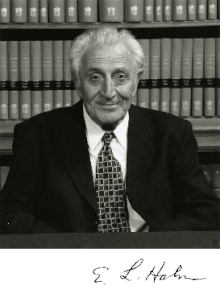
Summary
Erwin Louis Hahn (June 9, 1921 – September 20, 2016) was an American physicist, best known for his work on nuclear magnetic resonance (NMR).[1] In 1950 he discovered the spin echo.[2]
Erwin Hahn | |
|---|---|
 | |
| Born | Erwin Louis Hahn June 9, 1921 |
| Died | September 20, 2016 (aged 95) Berkeley, California |
| Alma mater | Juniata College University of Illinois |
| Awards | Oliver E. Buckley Condensed Matter Prize (1971) Wolf Prize in Physics (1983/4) |
| Scientific career | |
| Fields | Physics |
| Institutions | Stanford University University of California |
Education edit
He grew up in Sewickley, Pennsylvania. He received his B.S. in Physics from Juniata College and his M.S. and Doctor of Philosophy from the University of Illinois at Urbana–Champaign. He served as an enlisted sailor in the United States Navy and was an instructor on radar and sonar.[3]
Career and research edit
He was professor of physics, from 1955 to 1991, and subsequently, Professor Emeritus at the University of California, Berkeley. Hahn was elected a Fellow of the American Academy of Arts and Sciences in 1971.[4] In 1993 he was awarded the Comstock Prize in Physics from the National Academy of Sciences.[5] In 2013, Sir Peter Mansfield said in his autobiography that Hahn was "the person who really missed out" the Nobel Prize for his contribution to the principles of spin echoes.[6] He also received the 2016 Gold Medal from the International Society for Magnetic Resonance in Medicine (ISMRM). The award, ISMRM's highest honor, was given to Hahn for his creation of pulsed magnetic resonance and processes of signal refocusing which are essential to modern day MRI.[7] He died at the age of 95 in 2016.[8]
See also edit
- Pulsed magnetic resonance--NMR, ESR, and optics: a recognition of E.L. Hahn. Oxford University Press. 1992. ISBN 0-19-853962-2.
References edit
- ^ Filler, AG: The history, development, and impact of computed imaging in neurological diagnosis and neurosurgery: CT, MRI, DTI: Nature Precedings doi:10.1038/npre.2009.3267.4.
- ^ Hahn, E.L. (1950). "Spin echoes". Physical Review. 80 (4): 580–594. Bibcode:1950PhRv...80..580H. doi:10.1103/PhysRev.80.580.
- ^ Pines, Alexander; Budker, Dmitry (2019-12-01). "Erwin Louis Hahn. 9 June 1921—20 September 2016". Biographical Memoirs of Fellows of the Royal Society. 68: 219–230. doi:10.1098/rsbm.2019.0038.
- ^ "Book of Members, 1780–2010: Chapter H" (PDF). American Academy of Arts and Sciences. Retrieved September 22, 2016.
- ^ "Comstock Prize in Physics". National Academy of Sciences. Archived from the original on 29 December 2010. Retrieved 13 February 2011.
- ^ Peter Mansfield (2013). The long road to Stockholm. The story of MRI. An autobiography. p. 217. ISBN 978-0-19-966454-2.
- ^ "Erwin Hahn Receives Gold Medal Award". Physics @ Berkeley. Archived from the original on October 2, 2016. Retrieved September 29, 2016.
- ^ "Remembering Erwin Hahn". Physics @ Berkeley. Archived from the original on September 24, 2016. Retrieved September 23, 2016.
External links edit
- Oral History interview transcript with Erwin L. Hahn on 21 August 1986, American Institute of Physics, Niels Bohr Library and Archives
- Alexander Pines and Dmitry Budker, "Erwin L. Hahn", Biographical Memoirs of the National Academy of Sciences (2019)
- The Transformative Genius of Erwin Hahn - Interview published 8 May 2016, Magnetic Resonance in Medicine Highlights.
- Download the entire Highlights print supplement featuring this story at: http://www.ismrm.org/MRM/mrm_highlights_magazine.pdf


